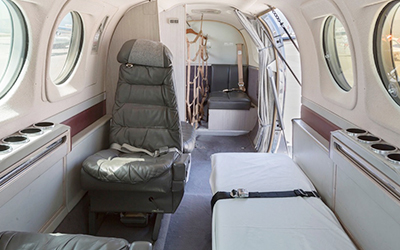In the world of emergency medical services, every second counts. When lives are on the line, swift and efficient care is paramount. One critical aspect of this care is the role of technology in air ambulance operations. Over the years, advancements in technology have revolutionized the way air ambulance services operate, enhancing patient care, safety, and overall efficiency. In this blog post, we’ll take a closer look at the pivotal role technology plays in these life-saving operations.
Real-time Communication and Coordination
Effective communication is the backbone of air ambulance operations. Modern technology has significantly improved communication both within the aircraft and between the aircraft and ground-based teams. Here’s how technology is making a difference:
- Satellite Communication: Air ambulances rely on satellite communication systems, allowing for uninterrupted connectivity even in remote or challenging terrain. This ensures that medical teams can communicate with receiving hospitals, control centers, and experts in real time.
- Telemedicine: Telemedicine solutions enable medical professionals on board to consult with specialists at the receiving hospital, making critical decisions and providing advanced care before the patient even arrives. This real-time collaboration saves precious minutes and improves patient outcomes.
Advanced Medical Equipment
Equipping air ambulances with cutting-edge medical technology is vital for patient care during transit. The technology onboard ensures that patients receive the highest level of care possible:
- Advanced Monitoring: Patients are continuously monitored with state-of-the-art equipment. This includes EKG machines, ventilators, and vital signs monitors, all of which provide real-time data to the medical team.
- Medical Records and Data Management: Electronic health records (EHRs) are now standard on air ambulances, allowing for seamless data transfer between the pre-hospital and hospital settings. This enhances patient care and ensures that critical information is readily available to the receiving medical team.
Navigation and Safety Systems
Safe navigation is paramount for air ambulance crews, especially during adverse weather conditions or challenging terrain:
- GPS and Navigation Tools: GPS navigation systems help pilots precisely locate their position and follow predetermined flight paths. These systems are essential for safe and efficient travel, especially during medical emergencies where time is critical.
- Terrain Awareness and Warning Systems (TAWS): TAWS technology provides real-time alerts to pilots about potential obstacles, including terrain and obstacles in their flight path. This reduces the risk of accidents during difficult weather conditions.
Aircraft Design and Safety
Advancements in aircraft design and safety technology have significantly improved the overall safety of air ambulance operations:
- Crash-resistant Fuel Systems: Modern air ambulance helicopters and fixed-wing aircraft are equipped with crash-resistant fuel systems, reducing the risk of post-crash fires and improving crew and patient safety.
- Noise Reduction: Noise reduction technology not only improves the comfort of patients and medical personnel but also reduces the risk of hearing damage for long-term crew members.
Conclusion
Technology has become an indispensable ally in the world of air ambulance operations. From real-time communication and advanced medical equipment to navigation and safety systems, it plays a pivotal role in ensuring that critically ill or injured patients receive the care they need, when they need it the most. As technology continues to advance, we can expect even greater improvements in patient outcomes and the overall efficiency of air ambulance services, reaffirming their vital role in emergency healthcare.


